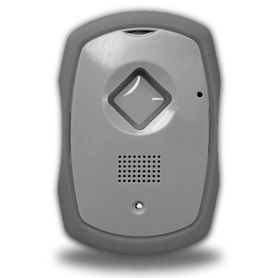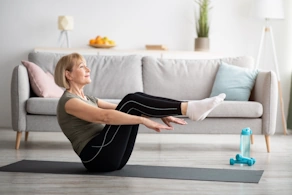Best Abdominal Stretches For Seniors: Relieve Tension & Improve Flexibility
Maintaining flexibility and core strength supports healthy aging, but many Canadian seniors overlook the importance of stretching their abdominal muscles. Abdominal stretches help improve posture, enhance balance, and relieve tension in the lower back and midsection. A strong and flexible core also supports mobility, making daily activities like bending, standing, and walking easier.
Incorporating gentle stretches into a routine can promote long-term wellness and reduce discomfort caused by stiffness or inactivity. Learning the proper way to stretch safely ensures greater flexibility, reduces the risk of injury, and supports overall well-being.
Life Assure Product Quiz
Find The Perfect Medical Alert Device
Take our 30 second quiz and discover which Life Assure medical alert device is the right fit for you or a loved one.
Life Assure Product Quiz
Find The Perfect Medical Alert Device
Take our 30 second quiz and discover which Life Assure medical alert device is the right fit for you or a loved one.
Benefits Of Abdominal Stretches For Seniors

Abdominal stretches contribute to better posture, balance, and flexibility, all becoming increasingly important with age. Maintaining good posture helps prevent back pain and musculoskeletal issues, as proper spinal alignment reduces unnecessary strain on the back and neck.
A strong core also plays a crucial role in stability. Balance naturally declines over time, increasing the risk of falls—a major concern for many seniors. Stretching the abdominal muscles supports core strength, helping seniors stay steady on their feet and making daily activities safer and more manageable.
Beyond physical benefits, stretching promotes relaxation and mental well-being. Slow, controlled movements encourage deep breathing and mindfulness, which can reduce stress and improve overall mood. This calming effect supports a more enjoyable and active lifestyle, allowing seniors to move with greater confidence and ease.
Incorporating abdominal stretches into a daily routine can help Canadian seniors maintain both physical and mental well-being, enhancing independence and quality of life.
Safety Considerations For Seniors
Before starting any new exercise routine, seniors should talk to their healthcare provider. They will consider health conditions and suggest exercise adjustments to fit individual needs.
While abdominal stretches offer many benefits, improper technique or overexertion can lead to discomfort or injury. To stretch safely, seniors should:
- ● Use proper form: Moving slowly and avoiding sudden jerks helps prevent strain on the muscles and joints.
- ● Avoid overextending: Stretching should create a gentle pull, not pain. Holding a stretch too aggressively can cause muscle strain.
- ● Modify movements as needed: For extra support, seniors with mobility limitations can use a chair, cushion, or wall.
- ● Stay hydrated: Muscles function best when properly hydrated, reducing the risk of cramping.
- ● Listen to the body: If a stretch feels uncomfortable or painful, stop and adjust to a more comfortable position.
By following these precautions, seniors can safely incorporate abdominal stretches into their routine while minimizing the risk of injury.
Preparing For Abdominal Stretches
Warming up before performing abdominal stretches is essential to loosen muscles and reduce the risk of strain. A gentle warm-up increases blood flow, making muscles more flexible and responsive to stretching.
Simple warm-up exercises include:
- ● Marching in place: Gently lifting the knees for 1–2 minutes helps activate the core and improve circulation.
- ● Shoulder rolls: Rolling the shoulders forward and backward loosens tension in the upper body.
- ● Deep breathing exercises: Practicing slow, controlled breaths prepares the body for movement while promoting relaxation.
Creating a safe and comfortable environment is just as important. Seniors should:
- ● Stretch on a stable surface such as a yoga mat, carpet, or supportive chair to prevent slipping.
- ● Wear comfortable clothing that allows for free movement.
- ● Stretch in a well-lit, quiet space to stay focused and avoid distractions.
By preparing properly, seniors can perform abdominal stretches more effectively and confidently.
Abdominal Stretches For Seniors: Step-By-Step Guide

Correctly performing abdominal stretches maximizes the benefits while minimizing strain. Each stretch is designed to be gentle and accessible for seniors, promoting flexibility and core strength.
Seniors should breathe steadily through each stretch and avoid pushing beyond their comfort level. Consistency ensures gradual improvement in flexibility and core strength.
Seated Forward Bend
Sit at the edge of a sturdy chair with feet flat on the ground. Lean forward from the hips, reaching toward your toes while keeping your back straight. Aim for a gentle stretch without discomfort. This targets the lower back and hamstrings, easing tension and enhancing flexibility.
Standing Side Stretch
Stand with feet shoulder-width apart. Raise one arm overhead and lean to the opposite side, keeping your body aligned. Hold for a few breaths, then switch sides. This stretch benefits the obliques and improves lateral flexibility, aiding balance and stability.
Cat-Cow Stretch
On all fours, position hands under shoulders and knees under hips. Arch your back upward (cat position), then lower your belly while lifting your head and tailbone (cow position). This dynamic stretch enhances spinal flexibility and engages the core, easing back stiffness.
Reclining Abdominal Stretch
Lie on your back with arms extended overhead and legs stretched out. Gently arch your back, allowing the spine's natural curve to lift slightly. This stretch targets core muscles and promotes relaxation, providing a soothing end to your routine.
Tips For Incorporating Abdominal Stretches Into Daily Routine
Making abdominal stretches a regular habit helps seniors maintain flexibility and reduce muscle tension over time. Small adjustments to daily activities make it easier to stay consistent.
- ● Pair stretching with existing routines: To reinforce consistency, perform stretches after waking up, before bed, or following a short walk.
- ● Use reminders: Set a daily alarm or place a note somewhere visible to encourage regular stretching.
- ● Modify as needed: If standing stretches feel too challenging, perform seated variations for comfort and accessibility.
- ● Listen to the body: Stretching should feel gentle, never painful. If discomfort occurs, adjust movements or consult a healthcare provider.
- ● Stay hydrated: Muscles respond better to stretching when properly hydrated, supporting overall mobility.
Building a habit of stretching just a few minutes per day can lead to improved flexibility, reduced stiffness, and better posture, helping seniors stay active and independent.
Conclusion
Incorporating abdominal stretches into a daily routine supports core strength, flexibility, and overall well-being. These simple yet effective movements enhance posture, improve balance, and promote relaxation, helping seniors maintain mobility and independence.
Consistency is key—even a few minutes of stretching each day can make a meaningful difference. By prioritizing gentle movement and listening to their bodies, seniors can enjoy a more active, pain-free lifestyle well into their golden years.
Start today and experience the benefits of a stronger, more flexible core!.











 Get Help With The Push Of A Button
Get Help With The Push Of A Button















